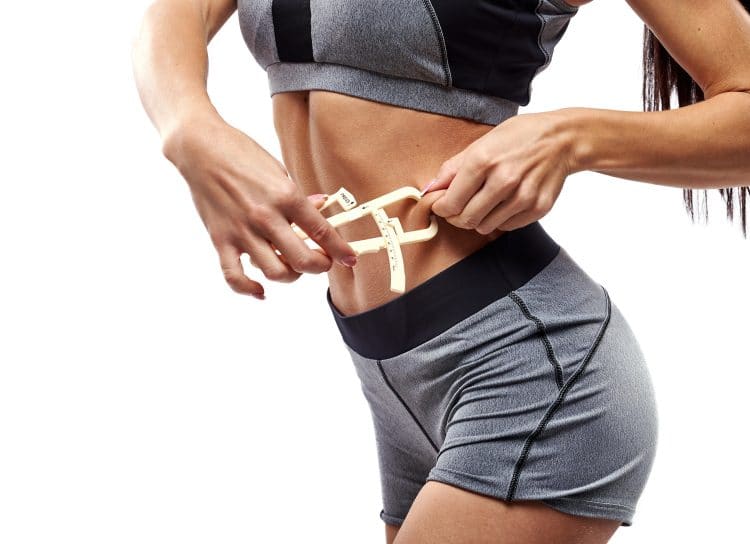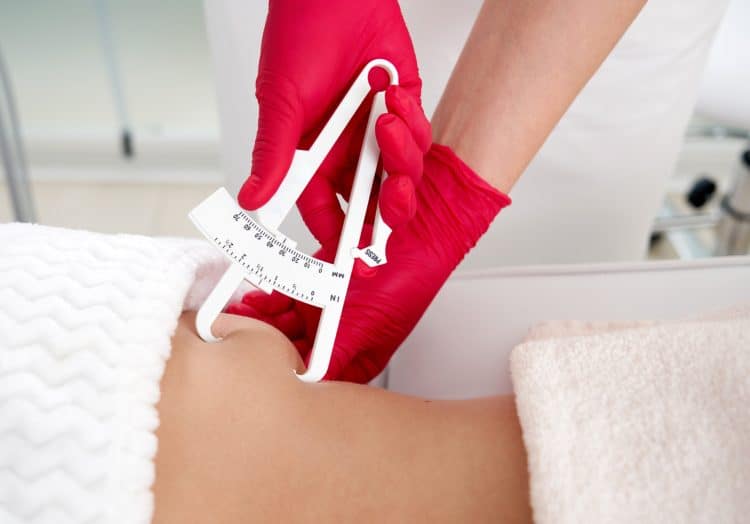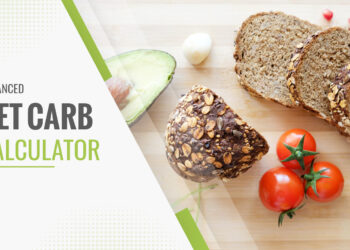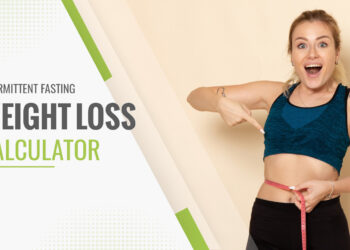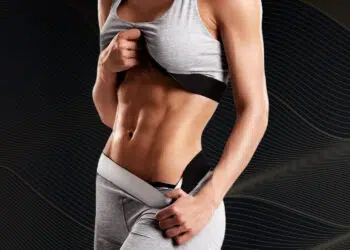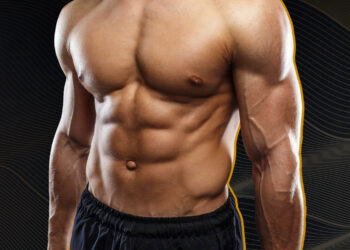The 7 skinfold body fat calculator can help you approximate your body fat percentage and lean to fat mass tissue ratio (body composition), plus learn what fat category you’re in.
Measurements - 7 Skinfolds Formula
How Do Skinfold Measurements Work?
The body fat skinfold calculator is based on a formula that estimates body fat percentage, body composition (lean to fat mass ratio), and fat category; essentially what kind of shape you’re in.
The skinfold testing process involves using a caliper device or even simply two fingers (thumb and index finger) to pinch folds of skin with the underlying subcutaneous fat tissue. You then measure the thickness using the caliper or a soft measuring tape.
Many trainers and health professionals test their clients’ body fat percentage using the skinfold technique. It’s also possible to do it yourself or with someone’s help.
Although it’s most important that you a) do it the same each time (whether you or someone else takes your measurements to ensure consistent results), and b) make sure that whoever does it is doing it correctly.
There are also a few different versions of skinfold spot testing. For example, the 3 site skinfold test measures three common fat-storing zones such as chest, abdomen, and thigh (common for men), or triceps, thigh, and suprailiac (common for women).
Level Up Your Fitness: Join our 💪 strong community in Fitness Volt Newsletter. Get daily inspiration, expert-backed workouts, nutrition tips, the latest in strength sports, and the support you need to reach your goals. Subscribe for free!
The 7 skinfold test, on the other hand, requires measuring seven spots including the chest, abdomen, thigh, triceps, axilla, subscapula, and suprailiac.
Common skinfold sites based on formulas:
- 3 skinfolds – Chest, abdomen, thigh (men) or triceps, thigh and suprailiac (women)
- 4 skinfolds – Triceps, thigh, suprailiac, abdomen (same for men and women)
- 7 skinfolds – Chest, abdomen, thigh, triceps, axilla, subscapula, and suprailiac (same for men and women)
Why Should You Measure Your Body Fat?
There are a few examples of why people want to keep track of their body fat.
General health
First off, having an idea of your fat tissue percentage as well as lean to fat mass ratio can help you determine what kind of shape you’re in, and not to mention, it’s one predictor of health risks such as diabetes, heart disease, cancers, and more.
Carrying excess fat storage around the waist especially puts one at risk. In fact, this risk goes up for women with a waist size larger than 35 inches in circumference while it’s more than 40 inches for men (1).
Having a healthy body fat range should be a priority for everyone when it comes to both short and long-term health.
Athletes, aesthetics, and performance
Athletes tend to be faster, more agile, and more able to perform longer when they have lower body fat levels. This is especially important for those who have to rely on speed, agility, and endurance.
That’s not to say there aren’t amazing athletes who have more body fat. In fact, packing on the blubber can be advantageous for strength athletes such as strongmen and powerlifters.
Consuming more calories than your body needs will cause weight gain. But here’s the kicker, fat gain is also accompanied by an increase in muscle mass. This is even more pronounced when the person does resistance workouts (highly recommended).
It’s just an easier and faster way to get stronger (2).
So while fat does not produce force like muscles do, having more muscle helps to produce more force and therefore perform better.
Bodybuilding and aesthetics
Bodybuilders and fitness competitors compete in the only sport where it’s necessary to have incredibly low body fat. That’s obviously because it’s a sport that judges based on body composition and conditioning or how shredded and lean the athletes are.
But even people who don’t compete want to be leaner and fitter and that also means losing body fat.
How To Use The 7 Skinfold Body Fat Skinfold Calculator
The 7 skinfold body fat skinfold calculator is very easy to use once you’ve got your measurements. We’ve included step-by-step instructions below.
Step 1: Choose the desired unit of measurement: Imperial (lbs) or metric (kg)
Step 2: Select your gender
Step 3: Enter your weight
Step 4: Type in your age
Step 5: Take your skinfold measurements and enter the values into the boxes.
Step 6: Click Calculate!
Taking 7 Skinfold Measurements
You want to make sure this part is done correctly for consistent results.
If using the caliper or thumb and index finger to pinch the folds, you want to make sure you’re only grasping the fat and not the muscle too. You can feel the muscle underneath and if that is the case, bring your fingers closer together until you’re only pinching and pulling the fat. Adjust your grip as needed.
If possible, have someone assist you. However, there are many great resources that’ll help you perform body fat testing on yourself. Whatever you do, be consistent with how you measure.
You should also take a minimum of two measurements per skinfold area for best results and it’s also a good idea to wait a few seconds between measurements.
If measurements are off by more than 1mm after multiple tries, take another and use the average of those. Measure roughly 1 cm above or below the skinfold.
It’s also commonly recommended to test the right side of the body for consistent measurements.
We’ve included a video example and previous explanations for how to measure each area below.
Chest
The chest skinfold is measured diagonally and a little higher than where’d you’d draw a line from the nipple to armpit.
Abdomen
Pinch a vertical skinfold on the right side of the navel or belly button.
Thigh
Lift the upper leg as high as possible and take a vertical skinfold measurement between the hip and knee joints.
Triceps
With the arm relaxed, pinch a vertical fold halfway between acromion (bony protrusion at top of shoulder) and the olecranon processes or bony point of the elbow.
Suprailiac
This should be a diagonal fold (downward angle from back to front) about 1 cm above the anterior superior iliac crest or the top of the hip bone.
Axilla (midaxillary)
This site is not as common as the others however, it is part of the 7 skinfold measurement.
For this measurement, draw an imaginary vertical line from the mid axilla or middle of the armpit to where the lowest part of the breastbone is.
Pinch a vertical skinfold to get your measurement.
Subscapula
Pinch a diagonal skinfold (right to left downward angle) 1-2 cm below the bottom of the right shoulder blade. Place the arm behind the back to more easily locate the bottom of the scapula.
Reading The Results
Now it’s time to go over your results based on the details you entered into the 7 skinfold body fat calculator.
It shows the following details in the same order. and we’ve explained how to interpret each one below.
- Body fat (percentage)
- Fat mass (fat weight in pounds/kg)
- Lean mass (lean weight in pounds/kg)
- Fat category (e.g, fit, athletic, acceptable, obese)
Body fat is the percentage of your body that is composed of fat tissue.
Fat mass is your weight in fat pounds/kg.
Lean mass is your weight in lean pounds/kg (e.g, muscle, bones, organs, skin, etc, and excluding fat mass).
Level Up Your Fitness: Join our 💪 strong community in Fitness Volt Newsletter. Get daily inspiration, expert-backed workouts, nutrition tips, the latest in strength sports, and the support you need to reach your goals. Subscribe for free!
Fat category is pretty much an assessment of your current physical shape.
Jackson and Pollock Formula
The 7 skinfold body fat calculator uses the Jackson and Pollock formula (Developed by Dr. Andrew Jackson and M.L. Pollock) to approximate body fat and body composition.
Below you’ll find the 7 skinfold Jackson and Pollock bone density and body fat formulas for men and women.
Men
Body Fat Percentage = [(495 / Body Density) – 450] x 100
Women
Body Fat Percentage = [(495 / Body Density) – 450] x 100
Body Fat Testing Methods: How Do They Compare?
Not all body fat measuring methods are the same.
Whichever you choose though, will likely depend on a few different factors such as budget, convenience, frequency of use, and how accurate you truly care to be with your estimates.
However, the skinfold spot test is probably the best option for most people as it’s cheaper, simpler, and very user-friendly. All you have to do is take a few measurements and enter them into this quick and easy tool. We can’t say the same for a lot of the other methods out there.
You can weigh yourself using a scale to monitor your progress, however, most don’t display your body fat percentage. Although, there are some really great and decently accurate body fat analyzer scales that use bioelectrical impedance analysis (BIA) to guess body fat numbers. These can be pretty costly though.
While the mirror is a good tool to guesstimate bf percentage, this is better left to more experienced people, and even then, if you want the body fat numbers, the mirror won’t give it to you.
Skinfold measurements can get you close
Skinfold assessments, when done correctly, can give you a good place to start. Not to mention, calipers can be found cheap or you could just use a soft measuring tape and two fingers (whether yours or a helper’s).
The more expensive but likely more accurate body fat tools
There are many body fat measuring tools out there that may give you a bit more accuracy as to your true body fat percentage. These are often a bit more expensive to have done compared to skinfold testing though, and still, you’re likely to see some difference between them regarding the results.
Hydrostatic weighing and DEXA/DXA scan (referred to as Gold Standards) could get you closer to the real numbers and aside from the jump up in cost (compared to a cheaper caliper or using two fingers), you’ll have to do them at a facility that offers these options.
Skinfold measurements, when done the right way, are still superior to simple calculator tools that only require your gender, age, height, and weight. You’ll also likely get more realistic results than using a cheap body fat scale and some BIA devices.
All of this may be helpful to know, however, again, what may matter more is that regardless of the method you use, consistency is key. If you can physically see and monitor your progress and your method is reflective of that then you’re on the right track.
But also, familiarizing yourself with what certain body fat percentages look like will help you a lot during your journey.
Try our US Navy body fat calculator to determine if you meet military standards.
Body Fat Between Genders (How Fat Affects Men and Women Differently)
Men and women are biologically very different and so is how they store body fat (3).
Females tend to accumulate fat tissue in the lower body areas such as glutes, thighs, and hips. In contrast, males naturally store fat in the midsection and upper body areas such as the chest, shoulders, face, and neck.
Women also typically have a higher body fat percentage because it’s very important for reproduction. Although, we’re not implying that being overweight is good.
The American Council on Exercise (ACE) has body fat charts on their site that display recommended body fat percentages for both men and women. So for example, women should be in the 10-13% range for essential fat (amount of fat needed for basic health and bodily function). This number is 2-5% for men.
“It’s comforting to know that women can be and should be fatter than men. They have a totally different reproduction function and the higher fat in women supports that reproductive function,” says Barbara J. Moore, PhD, president of Shape Up! America.
Type of body fat and health
While body fat percentage is one thing, the type of body fat is another.
Visceral fat
When it comes to body fat, you simply cannot lump them all into one category.
For example, visceral fat is a type of fat that wraps the abdominal organs such as the stomach, intestines, and liver, and it can even accumulate in the arteries.
For this reason, it’s sometimes referred to as “active” fat, which means it can have a more pronounced effect on health, making you more prone to diseases such as diabetes, heart disease, etc.
Subcutaneous fat
Unlike subcutaneous fat which is stored just beneath the skin and the type you can grip to take skinfold assessments, visceral fat is stored deeper in the abdomen.
Subcutaneous fat is the stuff you can jiggle when you grab your belly and other fatty areas. It makes up most of our fat stores.
That doesn’t mean you’re OK to gain a bunch of subcutaneous fat (not that you could control what type of fat you gain).
The best thing anyone can do is focus on a healthy diet and getting to a healthy body fat percentage.
Difference Between Measuring Body Fat and Measuring Body Mass Index (BMI)
Body mass index is an approach used by doctors and other health professionals to determine if someone is at a healthy or unhealthy body weight.
BMI does not estimate body fat/lean to fat mass ratio
The most basic BMI tool only requires two pieces of information to make this approximation – weight, and height.
But it does not give body fat details; rather a BMI score that determines what weight category you’re in (e.g, underweight, normal, overweight, obese).
“If we think of BMI being a rough measure of body fatness, there are people — especially some highly trained athletes — who are overweight but not overfat,” explained Steven Heymsfield, MD, director of the Obesity Research Center at St. Luke’s Roosevelt Hospital in New York. “Likewise, there are people who are of a normal weight according to BMI scales but who are overfat. BMI is a broad, general measure of risk. Body-fat assessment is much more specific to your actual fat content and thus provides a more accurate picture.”
BMI has its place though especially in the general, non-active, and non-weight-trained population.
You can make an assessment of someone’s health using the BMI formula especially if you can visually see that they may need to eat more or drop some fat pounds.
But assessing someone’s body composition is a better way to determine a healthy weight or weight range. Resistance training may cause someone to gain a lot of muscle, especially if they have really good genetics. This would put them at a higher BMI score.
There are really too many variables that you’d have to consider before judging someone’s health based solely on their height and weight.
Our BMI calculator is a great tool because it considers additional variables such as age and gender but also gives you a recommended weight range which is better than assuming someone is at an unhealthy weight based solely on their weight to height ratio.
Related Calculators:
- Body Fat Skinfold Calculator
- 3 Skinfold Body Fat Calculator
- 4 Skinfold Body Fat Calculator
- Body Fat US Navy Calculator
- Grecian Ideal Calculator
- Body Fat Calculator: Find Your Body Fat Percentage
- Calories Burned Weight Lifting
- Body Type Quiz
- Body Surface Area Calculator
- Calorie Deficit Calculator
Difference Between Skinfold Formulas
For the general population, the 3 skinfold body fat formula may be best. It’s simple to do and easier to reproduce in subsequent assessments.
The 7 skinfold assessment may be better for athletes and bodybuilders or those serious about testing their body fat and getting a more thorough evaluation.
However, why not try all methods and compare them? Then you could compare the skinfold test to some of the other body fat measuring methods as well.
Determine Your Body Fat Percentage Using The 7 Skinfold Body Fat Calculator
The 7 skinfold body fat calculator is just one of the many methods used to estimate body fat percentage, body composition, and fat category.
While it’s a rough guess, skinfold spot assessments have been shown to be a reliable method when used correctly and it’s a useful tool for measuring your progress.


